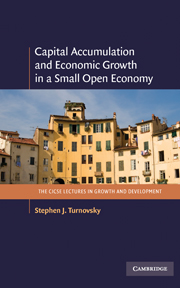Book contents
- Frontmatter
- Contents
- List of figures
- List of tables
- Preface
- 1 Introduction and brief overview
- PART ONE MODELS OF BALANCED GROWTH
- PART TWO TRANSITIONAL DYNAMICS AND LONG-RUN GROWTH
- 4 Transitional dynamics and endogenous growth in one-sector models
- 5 Two-sector growth models
- 6 Non-scale growth models
- PART THREE FOREIGN AID, CAPITAL ACCUMULATION, AND ECONOMIC GROWTH
- References
- Index
5 - Two-sector growth models
Published online by Cambridge University Press: 03 May 2010
- Frontmatter
- Contents
- List of figures
- List of tables
- Preface
- 1 Introduction and brief overview
- PART ONE MODELS OF BALANCED GROWTH
- PART TWO TRANSITIONAL DYNAMICS AND LONG-RUN GROWTH
- 4 Transitional dynamics and endogenous growth in one-sector models
- 5 Two-sector growth models
- 6 Non-scale growth models
- PART THREE FOREIGN AID, CAPITAL ACCUMULATION, AND ECONOMIC GROWTH
- References
- Index
Summary
Introduction
The one-sector production model, while an essential analytical tool of aggregate economics, is inevitably limited as a framework for analyzing the full economy-wide impacts of policy shocks and structural changes. This is particularly problematic in an international economy, one of the key characteristics of which is the fact that international trading activities affect different parts of the economy to varying degrees. Some parts of the economy are specialized in exports or export-related activities, others in imports or importrelated activities, while other sectors, notably service industries, operate more or less independently of the international environment. The differential impacts on these various sectors were a central issue in the debate over the Dutch disease and the discovery of oil in Northern Europe, as well as in assessing the effects of mineral discoveries in Australia. In both cases the discovery of the resource led to a change in the country's terms of trade, and this in turn had an effect on the country's traditional export sectors, as well as on its importcompeting sectors. Or, to take another example, a tariff imposed on a country's imports, by changing the country's terms of trade, will also have consequences elsewhere in the economy. To capture these relative price effects one needs to augment the basic model to introduce a second, or perhaps even more, sectors.
Two-sector models of economic growth were pioneered by Uzawa (1961), Takayama (1963), and others in the context of a closed economy.
- Type
- Chapter
- Information
- Capital Accumulation and Economic Growth in a Small Open Economy , pp. 104 - 132Publisher: Cambridge University PressPrint publication year: 2009

